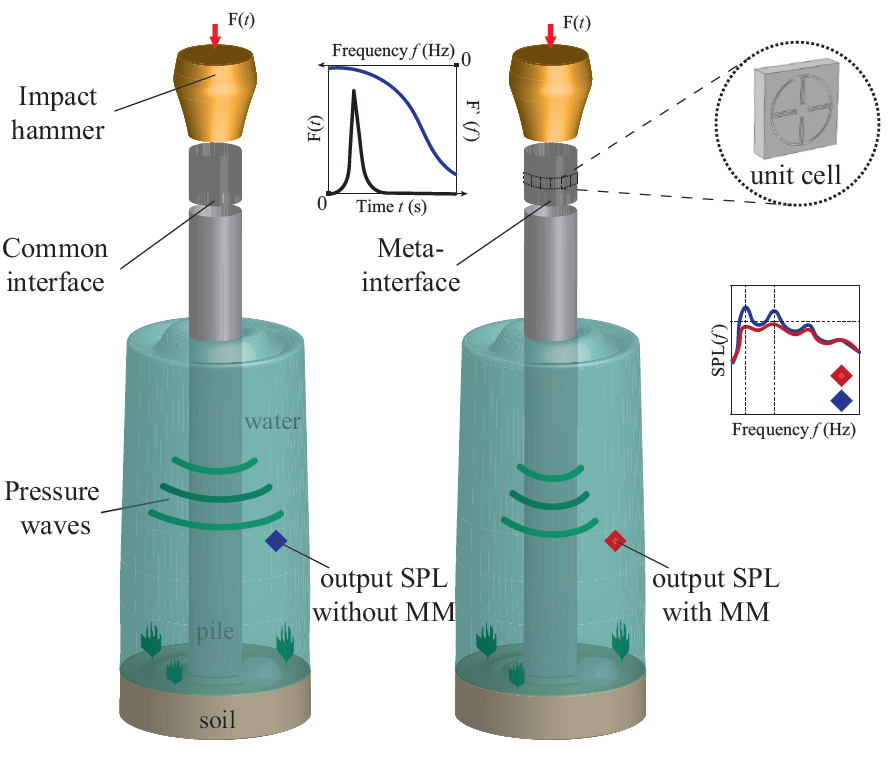Metastructures
A metamaterial-based cushion for the structural resonance shielding of impact-driven offshore monopiles
Underwater noise resulting from the monopile driving process can cause severe damage to marine wildlife, such as hearing injury, behavioral disturbance, or even death. Although current noise attenuation techniques used in this process have shown a significant noise reduction at high frequency ranges, mitigating low-frequency noise is still extremely challenging. To address the problem, here we propose an elastic metamaterial-based structure composed of single-phase resonant structures. The proposed structure, which we call a meta-cushion, is introduced between the monopile and the hammer and is used to remove energy from the input signal associated with high noise levels.
To that end, we first identify the frequency ranges associated with high sound pressure levels, which were shown to be related to the monopile’s eigenmodes. Then we design the meta-cushion’s periodic unit cells so that the elastic/acoustic waves at identified frequency ranges are attenuated. A meta-cushion is then realized by replicating the unit cell along the monopile wall (matching the thickness) to form a ring-shaped layer, and then by stacking up these concentric layers.
A frequency analysis of the pile driving system with the meta-interface shows that the new noise levels attain a significant attenuation in frequency ranges lower than 1000 Hz. This demonstrates a novel solution for the low-frequency underwater noise issue during the hammering of offshore monopiles. The meta-cushion’s attenuation mechanism is validated by performing impact testing in a small-scale monopile.
Additive manufacturing of NiTi architectured materials
In energy absorption applications, architectured metallic materials typically suffer from unrecoverable deformation due to local yield damage or inelastic buckling. Nitinol (NiTi), however, offers recoverable deformation and energy dissipation through its unique shape memory effect and superelasticity, revolutionizing the design and additive manufacturing of energy-absorbing architectured materials. These functionalities originate from the reversible Martensitic transformation.
Our project aims to develop NiTi architectured materials with adjustable properties using Powder Bed Fusion (PBF), a 3D printing technique for metals. This method allows precise control of the metallic microstructures by optimizing process and post-processing parameters, enhancing the transformation strain of NiTi alloys and the deformation recoverability of the architectured materials.
Comparative studies of different designs, such as truss-based and TPMS structures, revealed that local microstructures significantly influence deformation modes. This integrated approach, combining computational modeling and experimentation, enables us to tailor deformation recoverability by precisely designing both the mesoscopic structure and the microstructure.
The materials developed could serve as reusable impact absorbers in industries like aerospace, automotive, and maritime. They offer advanced, customizable solutions that enhance the performance and longevity of critical components across various sectors.
DYNRES: Dynamic response of resilient mounts
Underwater explosions and collisions produce shockwaves that can damage ships; the shock waves from these explosions produce large accelerations on ships which can damage onboard machinery and injure the crew. Resilient mounts are used to mitigate the impact of a shock on sensitive machinery and structures by reducing the acceleration transmitted above the mount, resilient mounts are often also expected to reduce acoustic noise and vibration transmissions in normal operation. Further, historic mount design has been based heavily on empirical data, modelling and testing that often does not reflect the real conditions of a shock, making it hard to assess the performance of new mount designs while the lack of clear theory makes it difficult to use older empirical knowledge to meet newer requirements.
This PhD research project will focus on developing modelling and a theoretical understanding of the dynamic responses of resilient mounts to shock and vibration. Further, we will explore developing design methodologies based on the modelling and theory results, that integrate metamaterial principles to propose new approaches for designing shock mounts.



